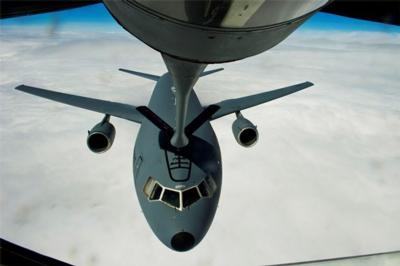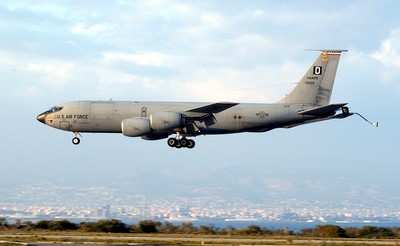Training Exercise Done In Complete Radio Silence
In a recent training mission, four KC-10 Extenders from the 305th Air Mobility Wing headquartered at Joint Base McGuire-Dix-Lakehurst, NJ, flew to a rendezvous point to meet with four KC-135 Stratotankers from the 6th Air Mobility Wing out of MacDill Air Force Base, FL. The KC-10s and the KC-135s flew to a designated point in a straight line a mile behind and 1000 feet above the preceding aircraft, in what is known as an En Route-Trail Formation.

The two sets of aircraft then shifted 60 degrees to the right placing two miles of open air between each other in their respective formations. The aircrews began the air-refueling portion of the mission with miles between each other. The KC-10 pilots took the aircraft off autopilot approximately a mile away from the KC-135s, and with all checklists complete, proceeded to fly toward the KC-135s, stopping 50 feet to stabilize. The KC-10 pilots then approached the KC-135s at about one-foot per second until the two aircraft were 10 feet apart.
The four KC-135s boom operators then lowered their booms to the KC-10s to begin the refueling portion of the mission. The aircraft conducted this maneuver in a 6,000-foot moving bubble of protected airspace between 24,000 and 30,000 feet above ground.
The KC-135 boom operators then moved their 15-foot booms into an approximate eight-inch air refueling receptacle on the KC-10s. The aircraft must stay connected for the duration of the refueling operation which takes approximately 15 minutes to transfer 13,000 gallons of jet propellant 8, while both aircraft maintain speeds in excess 420 mph. The KC-10 maintained this stable position while fighting turbulence and other weather conditions.
The KC-10s then perform a Waterfall Maneuver once the refueling operation was complete. This extremely precise maneuver involved the KC-10s slowly backing away from the KC-135s, one after another, beginning with the lead aircraft, and reforming back into En route-Trail Formation. Without precise timing, and attention to detail, aircraft could collide during this maneuver.
A mission like this requires precise timing, planning and execution and can test the mettle of any aircrew under normal circumstances. Now imagine performing this intricate mission in complete radio silence.
Student pilots from the 305th Operation Group's KC-10 Flying Training Unit, and members of the 32nd and 2nd Air Refueling Squadrons, conducted this radio-silent training mission, known as an Emissions Control 3 (EMCON III) large-formation operation, March 19, 2013.
The 6 hour-long EMCON III training mission is designed to enable pilots to deliver an air-strike package undetected while flying into hostile enemy airspace.

EMCON III is one of four EMCON statuses. EMCON I is completely open transmission. EMCON II limits voice communication reducing it completely while certain aircraft are in range. EMCON III restricts all radio communication and allows aircrew to use only specific emitters, such as transponder codes and navigational aids. EMCON IV limits all radio communication and emitter use.
"All aircraft emit infrared and electromagnetic energy through their engines, radios, radar, navigational aids and transponder codes," said Maj. Todd Swanhart, 305th Operational Support Squadron tactics KC-10 chief. "Radios put out the most useful energy to the enemy because it gives them direct information about the nature of the mission through voice communication, so we practice EMCON missions to prevent unnecessary emissions when needed during real-world scenarios."
An EMCON III mission requires a very high level of preparation and planning because timing is everything, explained Swanhart, who hails from Johnstown, PA. "It's a ballet in the sky and it's choreographed just like a dance," Swanhart said.
The 305th OG has worked with multiple wings to re-emphasize the strategic importance of flying in an EMCON-restricted environment, but the 305th AMW has taken the lead on refining this skillset and mission, Swanhart explained. "We are literally writing the tactics, techniques and procedures for operating in a restricted environment," said Swanhart. "Eighty percent of JB MDL tanker aircrews have been exposed to this and we're currently working to develop the program for the KC-135 weapons school and tankers across Air Mobility Command."
ANN Salutes 2nd Lt. David J. Murphy, Joint Base McGuire-Dix-Lakehurst Public Affairs.
(USAF Images)
 ANN's Daily Aero-Term (04.20.24): Light Gun
ANN's Daily Aero-Term (04.20.24): Light Gun Aero-News: Quote of the Day (04.20.24)
Aero-News: Quote of the Day (04.20.24) ANN's Daily Aero-Linx (04.21.24)
ANN's Daily Aero-Linx (04.21.24) Aero-News: Quote of the Day (04.21.24)
Aero-News: Quote of the Day (04.21.24) ANN's Daily Aero-Term (04.21.24): Aircraft Conflict
ANN's Daily Aero-Term (04.21.24): Aircraft Conflict




